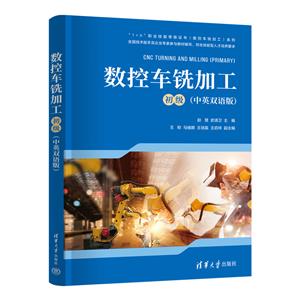-
>
中医基础理论
-
>
高校军事课教程
-
>
思想道德与法治(2021年版)
-
>
毛泽东思想和中国特色社会主义理论体系概论(2021年版)
-
>
中医内科学·全国中医药行业高等教育“十四五”规划教材
-
>
中医诊断学--新世纪第五版
-
>
中药学·全国中医药行业高等教育“十四五”规划教材
数控车铣加工(初级) 版权信息
- ISBN:9787302662839
- 条形码:9787302662839 ; 978-7-302-66283-9
- 装帧:平装
- 册数:暂无
- 重量:暂无
- 所属分类:>>
数控车铣加工(初级) 本书特色
紧密对接发布的“1 X”数控车铣加工职业技能等级标准。
采取渐进式的任务学习方式,介绍数控编程及加工的基本方法、工艺常识和操作技能
选用国内多种通用的CAD/CAM软件,设计典型教学案例及配套教学资源
数控车铣加工(初级) 内容简介
本教材作为《数控车铣加工》系列教材初级工分册,内容涵盖数控加工工艺、编程基础和机床操作三大部分内容。重点介绍数控车床、数控铣床和加工中心的编程指令、夹具、刀具、工艺流程、设备操作等专业知识。并根据技能型人才培养需求,科学设计了典型教学案例及配套教学资源,通过渐进式的任务学习及训练,使学生掌握数控编程及加工的基本方法、工艺常识和操作技能。本系列教材及配套资源可用于机械及相关专业的本科、专科、高职和专业培训院校的数控技术等课程的教材。
数控车铣加工(初级) 目录
Contents Projects Guidance Project 1Programming and Machining Training for Pin Shaft Turning Task 1Learn Key Knowledge Points 1.1Preliminary understanding of CNC lathes 1.2Turning features 1.3Knowledge of cutters 1.3.1Classification of cutters 1.3.2Cutters selection 1.4Knowledge of fixtures 1.5Knowledge of measuring tools 1.5.1Vernier caliper 1.5.2Micrometers 1.6Basic instructions 1.6.1Basic format of the CNC turning program 1.6.2Basic preparatory function instructions 1.6.3Miscellaneous function Mcodes 1.6.4CNC lathes utilize Tcode 1.6.5spindle function Scode Task 2Technological Preparation 1.7Parts drawing analysis 1.8Technological design 1.9CNC machining programming Task 3Handson Training 1.10Equipment and appliances 1.11Get to know the machine tool 1.11.1Power on 1.11.2Operation panel 1.11.3Return to reference point 1.12Cutters preparation 1.13Set the workpiece origin 1.13.1Zaxis origin setting 1.13.2Xaxis origin setting 1.14Program editing 1.15Simulation of CNC machining program 1.16Part machining 1.17Part inspection Project Summary Exercises After Class Project 2Programming and Machining Training for Handle Turning Task 1Learn Key Knowledge Points 2.1Basic instructions 2.1.1Circular interpolation instruction 2.1.2Chamfer/Corner arc transition instruction 2.1.3Tool radius compensation instructions 2.1.4Profile modeling roughing turning cycle instruction G73 Task 2Technological Preparation 2.2Part drawing analysis 2.3Technological Design 2.4CNC machining programming Task 3Handson Training 2.5Equipment and appliances 2.6Check before powering on 2.7Preparation before machining 2.8Part machining 2.9Part inspection Project Summary Exercises After Class Project 3Programming and Machining Training for Drive Shaft Turning Task 1Learn Key Knowledge Points 3.1General knowledge of thread 3.1.1Classification of threads 3.1.2Representation of metric threads 3.1.3Calculation of dimensions related to thread turning 3.2Thread measuring tool 3.3Basic instruction Task 2Technological Preparation 3.4Part drawing analysis 3.5Technological design 3.6CNC machining programming Task 3Handson Training 3.7Equipment and appliances 3.8Check before powering on 3.9Preparation before machining 3.10Part machining 3.11Part inspection Project Summary Exercises After Class Project 4Programming and Machining Training for Drive Wheel Milling Task 1Learn Key Knowledge Points 4.1Preliminary understanding of CNC machining center 4.2Milling characteristics 4.3Knowledge of cutters 4.4Knowledge of fixture 4.5Knowledge of measuring tools 4.6Technology knowledge 4.6.1Positioning principle 4.6.2Benchmarks 4.6.3Principles for the formulation of machining process
specification 4.7Basic instructions 4.7.1Basic format of CNC milling program 4.7.2Commonly used preparatory function instructions 4.7.3Commonly used auxiliary function instructions Task 2Technological Preparation 4.8Part drawing analysis 4.9Technological design 4.10CNC machining program writing Task 3Handson Training 4.11Equipment and appliances 4.12Get to know the machine tool 4.12.1Power on inspection 4.12.2Operation panel 4.12.3Return to origin 4.13Cutters preparation 4.14Edge finder and workpiece alignment 4.14.1Installing the edge finder 4.14.2The machining center calls the edge finder 4.14.3Workpiece alignment 4.15Cutter setting 4.16Program editing 4.17Simulation of CNC machining program 4.18Part machining 4.19Part inspection Project Summary Exercises After Class Project 5Programming and Machining Training for Geneva Wheel Milling Task 1Learn Key Knowledge Points 5.1Function and principle of coordinate system rotation 5.2Format and application of subprogram 5.2.1Format of subprogram 5.2.2Call subprogram 5.2.3Application of subprogram when a similar shape is
processed repeatedly 5.2.4Application of subprogram in layered processing Task 2Technological Preparation 5.3Part drawing analysis 5.4Technological design 5.5CNC machining program writing Task 3Handson Training 5.6Equipment and Appliances 5.7Check before powering on 5.8Part machine 5.9Part inspection Project Summary Exercises After Class Project 6Programming and Machining Training for Threaded Hole of Drive
Shaft and Driven Shaft
Task 1Learn Key Knowledge Points 6.1Common taps 6.2Tapping process method 6.3Thread bottom hole size for tapping cutting 6.4Operation method of thread tapping 6.4.1Hand tapping 6.4.2Mechanical tapping 6.5Tapping instructions 6.6Inspection of threaded holes Task 2Technological Preparation 6.7Part drawing analysis 6.8Technological design 6.9CNC machining program writing Task 3Handson Training 6.10Equipment and appliances 6.11Check before powering on 6.12Part machine 6.13Part inspection Project Summary Exercises After Class
数控车铣加工(初级) 作者简介
赵慧,天津轻工职业技术学院教师、铣工高级技师、讲师,研究方向为“多轴高速高精加工技术”,曾荣获天津市新长征突击手、天津市五一劳动奖章、天津市技术能手等称号,毕业后一直从事数控加工的技术及教学相关工作;曾作为短期技术专家,赴埃塞俄比亚进行技术援助;多次参加、指导学生参加省市级、国家级技能大赛。本人发表专业论文10篇,主编双语教材1部,参编教材1部,主持完成研究课题2项,横向课题2项,参与课题10项,项目到款额12万元;2022年3月获批天津市2022年度海河名师访学研修导师。
- >
中国人在乌苏里边疆区:历史与人类学概述
中国人在乌苏里边疆区:历史与人类学概述
¥25.0¥48.0 - >
随园食单
随园食单
¥15.4¥48.0 - >
上帝之肋:男人的真实旅程
上帝之肋:男人的真实旅程
¥19.3¥35.0 - >
大红狗在马戏团-大红狗克里弗-助人
大红狗在马戏团-大红狗克里弗-助人
¥3.6¥10.0 - >
龙榆生:词曲概论/大家小书
龙榆生:词曲概论/大家小书
¥9.2¥24.0 - >
名家带你读鲁迅:故事新编
名家带你读鲁迅:故事新编
¥12.6¥26.0 - >
经典常谈
经典常谈
¥19.5¥39.8 - >
小考拉的故事-套装共3册
小考拉的故事-套装共3册
¥36.7¥68.0
-
食品添加剂
¥33.5¥45 -
VB语言程序设计
¥29.9¥39.8 -
C语言程序设计习题与实验指导
¥9.1¥18 -
地下建筑结构-(第三版)-(赠课件)
¥49.4¥55 -
模具制图
¥37.8¥49 -
工程机械结构认知
¥10.5¥22



















